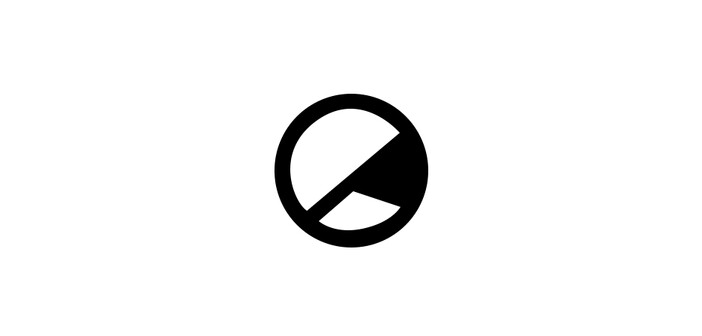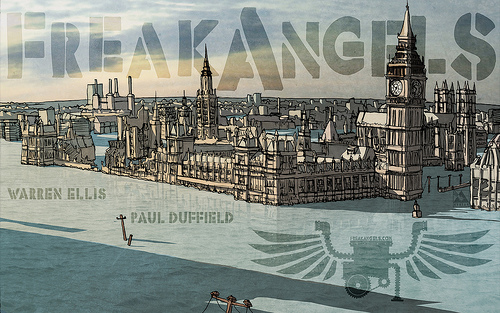
"Well done! You've saved the day! Let me reward you with these tickets to the circus and a slap-up feed at the Hotel De Posh!"
The Hotel De Posh's signature dish: a great mound of mashed potato, with sausages sticking out horizontally all round it, and a bottle of fizzy lemonade (or, more likely, Irn Brue). Desperate Dan's favourite, his Aunt Aggie's speciality, is far too famous for it to be worth my mentioning it here.
Oh, the roll-call of the heroes: Lord Snooty and his Pals, Roger the Dodger, Minnie the Minx, Dennis the Menace. (My brother's first word was not 'Mommy' but 'Nennis' as he called for his Dennis the Menace annual). Little Plum and the Three Bears. And Pansy Potter, who let slip her Dundee origins because her title didn't rhyme unless pronounced with a Scots accent. She was the strong man's dotter.
A subtle Scottish cadence ran through all the speech bubbles. People were sent to 'do messages', whereas in the Black Country, we ran errands. Dan's being called 'desperate' too - he was desperate in the sense of being wild and a handful rather than being at the end of his tether.
When I was a child, our house had lots of books - shelved floor to ceiling in most rooms, piled on the stairs and window-sills - but we were rarely bought comics. My parents had nothing against comics - far from it - but didn't think them worth spending their scarce income on, when they could buy us a second-hand book from Dudley market for little more.
Next door lived a brother and sister who were obviously filthy rich, because they each had several comics every week. On Friday evenings it was my regular chore to carry next door a lump of bloody meat wrapped in newspapers (the Sunday joint, delivered by a mobile butcher and taken in by my mother for her neighbour, who worked). Every month or so my reward was to have my arms piled with a stack of old comics and magazines. I'd scuttle home, clutching the pile, and burst in through the back door with a cry of, "Comics!"
"Bags me the Beano," my Dad would say.
There was The Bunty, The Judy, June, Jackie and, later, The Romeo and Valentine. Even, occasionally, The Red Letter, which my mother remembered from her own young days. Looking at the cover she said, with satisfaction, "They've still got the nasty neighbour spying round the curtains - she was always there, every week."
But the girls' comics were quickly skimmed through and thrown aside, with their tales of butch (female) car mechanics being made over to win beauty contests, and champion hockey-teams kidnapped to play for aliens. They were appetisers, something to read while other people had the comics you really wanted. While, for instance, my Dad had the Beano.
It was the boys' comics we really loved: The Beano, The Dandy, The Topper. The Valiant, the Hotspur, The Buster, the Victor. After we'd finished with them, my Dad took them to work, and his workmates read them during their tea-break, feet up on the stove, laughing at The Bash Street Kids. It takes a
real man, I think, to admit that he finds the Beano a good read.
My Dad, my brothers, sister and I, all drew. The house was littered with pencil ends and opened-out envelopes, covered in sketches. We studied the comic's drawings, as much as the words, and could never understand why friends never seemed to notice, or care, when a favourite strip was drawn by a different artist. The comic art was often of a high order, and taught us a lot. We much admired the drawings for 'The Steel Claw' in the Valiant, a sort of comic-strip noir. And the Bash Street Kids, careering along in a massed group, all feet off the ground at once, were a joy, full of liveliness and movement.
The artist who drew the thick, woodcut like strips for 'Faceache' and 'Jonah' was a master, his strips not only grotesquely beautiful, but laugh-out-loud funny. I remember one in particular, where Faceache resolved to be good. This turning over a new leaf was a regular motif in the strips of the 'naughty' characters, such as Dennis, Roger and Minnie.
Anyway, Faceache vowed that, for that day at least, he would cease from twisting his face into terrifying gurns, causing dismay and panic among the locals. Instead he would be good and help the baker. Cue a series of wonderfully managed panels where Faceache burning his hand coincides with an innocent delivery man looking in through the window just as pain convulses Faceache's already unlovely features into an especially novel shape. Panic and unrest ensues. It was filmic. I remember my Dad took that particular strip to read in the bathroom. He said it nearly gave him a rupture.
My siblings and I used to discuss and dissect the comics in a sort of junior book club. We scoffed at Captain Hurricane, his 'raging furies' and exclamations of 'Cowardly Cabbage Crunchers' and 'Suffering Sausages!" My mother told us that, as a child during the Second World War, she'd seriously believed that Germans only ever said, 'Achtung, Pig-dog!' Well, apart from 'Heil Hitler!' obviously.
We discussed whether it was sensible of Fish Boy (who'd been abandoned in the wild and raised by fishes) to take a wounded fish from the ocean and lay it on a rock to 'bathe its wounds'. And which was better - Galaxo, the giant robot ape, or the boy who controlled an army of little robots via his metal armband? We were cutting our critical teeth.
At the same time I was reading The Norse Myths, Hans Andersen, Kipling - but that was literature. I could enjoy it, but hands off.
Comics were on our level. Often well-drawn, funny, inventive, but emphatically not literature. We could kick them around, and say and think what we liked about them. We learned discernment for ourselves. Once learned - and not least of the lessons was that it was enjoyable - we could carry it with us into other fields.
I once read an article in which a critic declared that it was impossible to appreciate Mickey Mouse and Tolstoy equally. In order to be refined enough to enjoy Tolstoy, apparently, you had to leave Mickey far behind.
Rubbish. You can enjoy and appreciate Mickey - and Dennis and the Bash Street Kids - and Bugs Bunny, Daffy Duck and Yosemite Sam - for the skill, verve and wit that they have. And then you can shift gears and appreciate Tolstoy or Austen or Dickens, on their level, as artists who had entirely different aims. Just as you can appreciate both Hardy and Beatrix Potter. The ability to move from one to the other demonstrates a flexible mind - which is probably necessary for creativity.
George Orwell got a lot from smutty seaside postcards.
It takes a
real critic to appreciate both Mickey and Natasha.



















